Pokemon Tower Defense 2: Training & Levelling Walkthrough, Help, Wiki
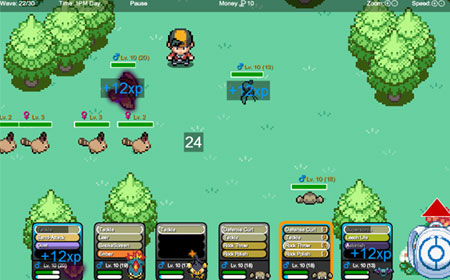
Table of Contents
- Let me introduce myself
- From Capture to Battle
- Perfect on paper; You Just Need More Experience
- Low Level? No Problem
- There's No 'I' In Team
- Tough trainers are XP Rainers
- I'd love to, but she's just not my type
- One Gift Please, but I can do without the mystery
- Let It Shine
- Burn the candle at both ends
- I like the Way You Move
- It's Super-Effective!
- Trading places
- Rolling in it? Then buy fictional success, with actual money!
- It's a Status Issue
- Hard Targeting
- This Concludes Our Broadcast Day
Let me introduce myself
Following on from a previous walkthrough of mine which attempted to shower the reader with the ins and outs, ups and downs and indeed the backs and forths of the spectacular Pokémon Tower Defence 2: Generations , I would like to put pen to paper (or at least fingers to keypad) in an effort to provide some more detail about the fairly lengthy process of training your Pokémon. Now, there will be many of you out there that are already knowledgeable to the point of absolute gleaming smugness about the particulars of Pokémon training in Pokémon Tower Defence 2; this guide is of course not meant for such individuals. Instead, I aim these musings at those who feel they are making little progress in the game, or that any progress they do seem to make is so painfully incremental that it makes the whole playing experience somewhat lacklustre and devoid of fun. This is exactly how I began my time with the game, and it would delight me to know that any number of the words that follow may help any struggling players see the true beauty of the game and realise the fun that they are missing out on.
The following guide will therefore delve into a fair level of detail about the process of capturing and training your Pokémon to a respectable level; what you do from this point onwards is completely up to you. If, like me, you began the game and quickly became frustrated by the poor performance of your Pokémon, then this guide may shed some light on where you have been going wrong, or at very least confirm the things that you were doing correctly so that you can continue to build on your already blooming techniques. The process of developing your freshly-caught Pokémon is a fairly slow one at the best of times, even when things are going swimmingly, so you can imagine the frustration of players who are not using their Pokémon to their full advantage in battle. To these individuals, there is a danger of the game becoming irritated and discouraged, with gameplay seeming like an increasingly fruitless task, when in actual fact it should really be a challenging, rewarding and altogether an incredibly entertaining experience. Enough of my justification for writing this piece; simply stop reading if you think you already know it all. For the rest of you, read on: I hope I can bring the joy of Pokémon back for you.
From Capture to Battle
We’ve all been there: you’ve begun a battle, moves have been exchanged, furious tapping of the mouse button at a machinegun pace occurs as standard (in spite of its ineffectiveness as user-input technique) and yet the outcome remains the same. Perhaps the Pokémon you desire had the audacity to faint just before you could swipe your mouse across to your bag in order to grab the Pokéball in order to capture it; maybe you used a move that was all too much for the opposing Pokémon; the battle might have even gone completely your way yet your Pokémon remain at the level they have been for what seems like an actual eternity. All these are common problems in the Pokémon universe in general, and are not issues that are simply limited to the world of Pokémon Tower Defence. While they may seem frustrating, these issues are actually very easy to overcome, and I will start where the whole process begins: the capturing of wild Pokémon.
Capturing Pokémon in the game is actually a far easier task than it is in the original Pokémon games for the Gameboy; the way to do so in the tower defence version is simply to wear down the opposing Pokémon’s health until it reaches a critical level (indicated by its health bar turning red), and when it does so, you are able to pop one of your unlimited supply of Pokéballs out of your backpack and capture the reeling creature. This is a simple process, but because things tend to go most wrongly at the time you need this to happen the least, unforeseen events often occur and the Pokémon ends up escaping or fainting; both are undesirable and render the Pokémon completely useless to you.
To enter a wild battle, simply wander around and the map and look for the little creatures hopping up and down, frolicking about and generally having a jolly old time out in the wild; this can be witnessed in the picture below. Unfortunately for them, their time experiencing the freedom of their natural environment is about to come to an abrupt end. Once you bump into the Pokémon you wish to capture, a battle will begin. More often than not, these battles will yield multiple Pokémon of the type you wish to capture, moving one after the other in single file from the left hand side of the screen to the right.
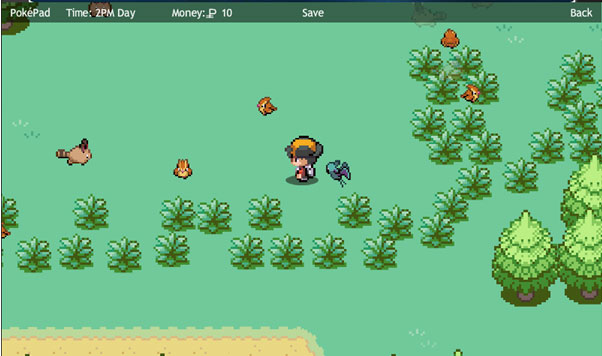
Wild Pokemon doing what they do best: wandering around and waiting to be challenged (above).
Once you are in the battle, the next step is obviously to deploy your Pokémon in order to attack the ones that are scurrying past, attacking you as they go. Since your intent is to capture, then I recommend summoning only one or two of your Pokémon, depending on how high their level is. Most wild Pokémon (at this stage of the game’s development, anyhow) are likely to be between levels three to six, depending on the area you are in. The Pokémon in battles against other trainers are usually of higher level than this, but we won’t be capturing these, so going into detail about them is all but pointless at this stage. As a final note, be wary of the type of Pokémon you are facing compared to the type which you are pitting against it; if your Pokémon is super-effective against the opposing one, then you are likely to knock it out before you get the chance to capture it.
The trick to successfully capturing wild Pokemon is firstly to identify the passing Pokémon’s level, then to focus your attacks on one or two of them by positioning your Pokémon nearer to them as they move. Using a Pokémon of similar level (if you have any) to the one you wish to capture can help reduce the risk of your opponent fainting prematurely, but if this is not possible, then simply keep an eye on their health bar closely. This is where the second trick comes into play: the moment you spot the opponent’s health bar turn red, simply press ‘P’ to pause the game. Since you can rifle through the items in your rucksack and even use them when the game is paused, simply switch you your Pokéball while the game is paused, click and drag it over the Pokémon with critical health until it opens up and then release the mouse button. Congratulations, you have now completed the first stage of the Pokémon process.
A certain percentage of wild battles will take place against a single opponent, removing the need to worry about multiple opponents and allowing you to concentrate on the single Pokémon in front of you. If your intent is to capture , then simply go about this kind of battle as you would a battle against multiple opponents, but rub your hands together with glee at the relative ease of facing a single Pokémon. These 1vs1 wild battles also yield proportionally more experience points for the Pokémon who deals the majority of the damage and also the defeating blow, but this aspect is covered in more detail below where the object isn’t to capture but to battle to the death for the sweet nectar of experience points.
Perfect on paper; You Just Need More Experience
You cannot play a Pokémon game in any context without being entirely reliant on the functional feature of experience points; from Pokémon Red on the original (old-school Black and White) GameBoy to the marvellous internet-based world of Pokémon Tower Defence, experience points matter because aside from Rare Candies, they are your only ticket to a stronger Pokémon who advances in an upwards fashion through the levels, gaining attribute points for their HP, attack, defence, and various other categories along the way. Levelling up is the main way to increase the effectiveness of your Pokémon against others who may be stronger than you, and the following paragraphs bring together little more detail on the matter, while the rest of the guide will furnish you with further particulars and tips on the matter.
In the most basic of terms, experience points are earned by your Pokémon during all types of battle when your Pokémon kills an opponent. The number of points earned shows up in blue numbering on the screen above the Pokémon you just annihilated (+20, +40 etc.) and also appears over the information card of your particular Pokémon across the bottom in the event that you get confused about where the points are going and/or are watching ridiculously closely or in super-slow motion. Experience points are even earned by Pokémon that don’t quite manage to finish the job and have to be assisted by the next creature in your roster of active Pokémon to polish them off once and for all.
When the number of your Pokémon that are active in any particular battle exceeds one, the experience points are shared equally between these Pokémon. Because it is fairly unlikely that you will possess any one Pokémon that is strong enough to fend for itself as the only active Pokémon in a battle, the sharing/splitting of experience points amongst your battle-present Pokémon is going to be the principal way in which you will be earning experience points in the game, at least for the majority of the game as it stands thus far.
As is mentioned in further detail in the sections which follow this one, it is a smart move to place the Pokémon that you wish to be the benefactor of the most experience points in the position that is closest to the point from which the line of Pokémon will enter. This way, the Pokémon will have a clear shot at all passing enemies and will not simply be waiting in a futile fashion as he would be if you placed him on the opposite side for a shot at whichever enemy Pokémon may or may not be left standing. Simply put, the Pokémon closest to the enemies’ point of origin will rake in the most experience
However, the previous statement only holds to be entirely true if the Pokémon it initially attacks actually goes on to be killed by another of your Pokémon, or indeed if you enter into the tedious, time-confusing and altogether inefficient practice of constantly moving the same Pokémon to different locations throughout the battle. The way to receive obscene quantities of signed, sealed and delivered (they’re yours) experience points from a battle is to ensure a stronger Pokémon is in place further away from the spawning location of the opposing Pokémon; the experience points will be shared between the participating parties accordingly.
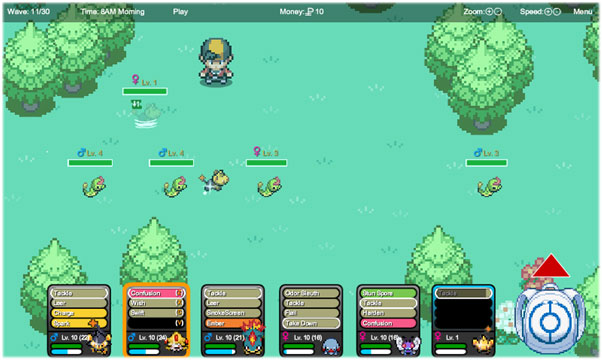
Deployment of a single, low-level Pokémon yields no advantage whatsoever; his moves are simply not strong enough in his youth to do anything more than gently tickle the passing Pokémon, an activity which bears no fruit. And by fruit, I mean experience points.
Since you will most likely be spending most of your time training up weaker Pokémon with the above strategy, it simply isn’t an effective approach to deploy your weaker Pokémon at a point that is away from all the action, or to deploy him singularly in a battle and simply hope for the best; the respective likely outcomes are that you will receive minimal experience points and that you will be killed before you can do any real damage. Weaker Pokémon that are freshly caught or that have been received in a trade/mystery gift will benefit from the help of a stronger Pokémon to assist them. It makes the process incredibly more efficient if this stronger Pokémon possesses a powerful move (often learnt between levels 10-14, but not necessarily) such as Confusion or Ember (depending on the kind Pokémon you own and the types you are up against; see ‘I’d Love to But She’s Just Not My Type’)
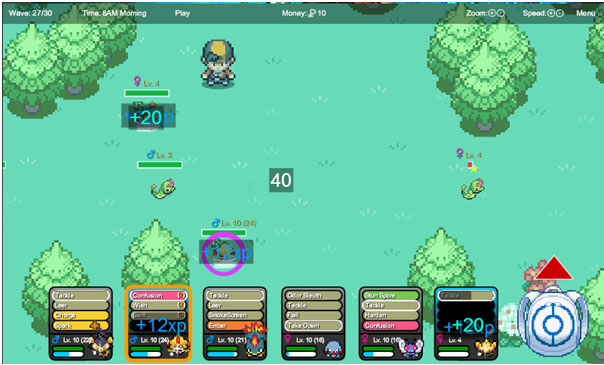
The pairing of the weak (Shiny Shinx, leftmost Pokémon) with the strong (Shiny Jirachi, the only other of my Pokémon to be deployed) is a sure-fire way to deliciously blue-tinted experience points; Jirachi’s powerful Confusion move ensures the demise of almost all who pass him whereas Shinx gets the lion’s share due to his proximity to the enemy spawn point.
Low Level? No Problem
Now that you have managed to get the hang of capturing wild Pokémon without letting them faint or taunt you in a demeaning way as they make their escape, you will find yourself in possession of an increasing number of Pokémon at distinctly mediocre or quite frankly poor levels of growth. The only way to combat the unfortunate condition of being at a lowly level 2 is to do what a Pokémon trainer does best: battle the hell out of your Pokémon and watch the experience points roll in.
Now, to say that the experience points will simply roll in effortlessly would be to grossly mislead you and embellish the harsh truth of the Pokémon universe. That is, if you want to own high-level Pokémon that will strike fear and envy into the collection of atria and ventricles that make up the heart of your victims, then you are going to have to put in the work to get them there. This means battling, and quite a lot of it.
Now, you have two options for which kinds of battles you can enter your Pokémon battles into: trainer battles (if you can find any) and wild battles, which are in plentiful supply and are by far the easiest to find. The first of the option I will be covering in this section is your basic, run-of-the-mill wild battle because you can’t really go anywhere in Pokémon Tower Defence 2 without running into a grassy area where Pokémon are freely roaming and behaving in their own unique ways. Thus far in the game, wild Pokémon can be found in Route 29, 30, 31, the area accessible to the north of Route 29, in the Rock cave, and also area that surrounds said cave. As you can see, if your intent is to train your Pokémon on a steady diet of fighting, then wild battles are going to be the staple meal.
Begin by approaching any wild Pokémon that takes your fancy; once you bump into the Pokémon in question, the battle will start. The most likely battle scenario is that of multiple opponents of the same Pokémon type, such as a passing parade Caterpies for example; each one is available to attack and to capture (should you not already own the Pokémon), but since your intention is to use the battle to gain the maximum number of experience points in the most efficient way possible, you will be attempting to defeat each of the Pokémon that pass by. Escaped Pokémon equate to a missed opportunity in grabbing some valuable experience points.
Now, regardless of the type of your Pokémon (type advantages/disadvantages will be discussed below) or of the ones which you are battling against, I recommend that you place your strongest Pokémon to the most extreme left position of all of the battle zones and that you place the lower-level Pokémon that you wish to be trained up to the right of the strongest . This will ensure two things: firstly, that the weaker Pokémon does not suffer the brunt of the attacks from the oncoming conveyor belt of attacking Pokémon entering from the left, since your stronger Pokémon is now first in the line of fire (don’t worry, it can take it). Secondly, this tactic ensures that your weaker Pokémon, while avoiding many of the attacks, will still get the chance to deal some damage to the passing Pokémon which have already been weakened by your strongest offering. In effect, your strongest Pokémon is simply chipping away at the opponents while your weaker one still gets a chance to be involved in the battle without being immediately defeated. This way, your weaker Pokémon gets a heftier share of the experience points.
There’s No ‘I’ In Team
If you are using strong/weak Pokémon technique above and still appear to be making unsatisfactory progress, or if many of the Pokémon that you are fighting simply appear to be getting away (and therefore aren’t being defeated and getting you the resulting experience points), then you can involve a third/fourth/fifth Pokémon in order to mop up the stragglers should your other Pokémon fail at getting the job done.

Accumulating experience points by sharing them with a stronger, more able Pokémon is the key to levelling up your weaker Pokémon at an accelerated pace (above).
As you can see in the picture above, I have recruited my level 18 Geodude (capped at level 10 in most wild battles, but this is a development ceiling of the game as it stands currently) in order to stand guard and watch for any Pokémon which manage to make it through the attacks from my Shadow Pidgeotto (the strongest of all my Pokémon and Zubat (the Pokémon which I am attempting to train to a higher level).
Since more experience points are gained by your Pokémon for actually defeating the passing Pokémon as opposed to merely attacking them a few times and allowing them to pass, use of the above technique means that my Zubat is guaranteed the maximum number of points with (hopefully) the least amount of damage. You can see the experience points being shared between Pidgeotto and Zubat in the above picture, which incidentally is a perfect visual demonstration of the strong/weak/strong formation of Pokémon that has been discussed. The technique engineers a pretty much win-win situation for your Pokémon, and to top it off nicely, the Geodude on the right will gain some experience points from any of the Pokémon which make it through the first two.
[Small tip: Because of the often slow and arduous nature of training up Pokémon, entering into consecutive wild battles and seeing them through to the final wave of Pokémon can be tiring and monotonous. In order to make things move at a faster and at a pace which is less taxing on your patience, simply increase the speed of the action (wait until you have placed your Pokémon and that you are happy with your formation first) by clicking the ‘+’ icon next to the ‘Speed’ setting in the top-right of the screen, just to the left of the ‘Menu’ button. Everything will play out as it would have at regular speed, but this way you can whizz through the wild battles and watch the experience points accrue as you rub your hands/lick your lips with delight]
You may be of the school of thought that was so common in the original (non tower-defence) Pokémon games in which you send out the Pokémon you wish to train into battle regardless of its weakness contrasting so significantly with the opponent’s strength. Simply put, this technique doesn’t quite apply to Pokémon Tower Defence 2 . In contrast, simply sending Zubat out as the only attacking Pokémon would result in either him fainting fairly quickly or in most of the passers by simply walking off relatively unharmed; neither of these outcomes are beneficial to your Pokémon, particularly if your intention is to gain as many experience points as is possible.
Going Solo
I mentioned above that the battles in which wild Pokémon trundle past in single-file are the most common, but what about when this isn’t the case? The other kind of wild battle involves a classic 1vs1 format whereby there is only one instance of the opposing Pokémon and also one single active battle zone for you to place a solitary Pokémon into. These kinds of battles aren’t as common as the others but they happen at a frequency which is predetermined by the game’s programming. While this kind of battle may not be as beneficial to your team as a whole when compared to the multiple-enemy battles, these solo exploits will propagate an increased number of experience points for whichever Pokémon you choose to fight and finish the job.

A solo Pokémon battle commences under cover of darkness (left). The experience points for one on one battles are rained upon the victorious Pokémon as if it were on your proverbial parade (right).
These battles do not require team tactics and cycling through your creatures or allowing each of them a shot at the Pokémon will offer little reward. The most important thing to remember when you encounter a 1vs1 wild battle is which Pokémon is in need of the highest number of experience points. Provided your Pokémon is a minimum of one level the opponent’s senior, then you should be able to come away victorious (as long as their attacks are not super effective against you). The main thing to take away from the solo battle is that they mean a chunk of experience points for a Pokémon of your choosing, whoever that may be. Use this to your advantage by entering the Pokémon that you determine is in most need of experience points from the battle.
Tough trainers are XP Rainers
The other kinds of Pokémon battle that tend to occur fairly infrequently in Pokémon Tower Defence 2 but which are an integral part in Story Mode, are the battles against other people (trainer/gym battles) or boss battles (often including battles against Pokémon significantly more powerful than you). In contrast to the light-hearted wild battles, battling other people/boss battles are sometimes a stressful affair in which the correct tactics must be employed in order to prevail. Now, I’m not going to offer a guide to completing the boss battles that have been included in the game so far. What I am going to shed light on however, is the useful tendency of these battles to offer a large amount of experience points for the Pokémon in your collection which feature most heavily within the battle.
Recognising that there is some benefit to fighting in battles with other Pokémon trainers is part of the process of training your Pokémon up through their different levels. While repeatedly entering into wild Pokémon battles is beneficial and will form the backbone of your training efforts, encountering trainers can see the reward of experience points for each defeated Pokémon shoot up dramatically. The first trainer you encounter in the game is Silver, your rival, and the most recent trainer is also the first Gym Boss of the game named Falkner.
NB. Fighting against Pokémon trainers or in the ‘Boss Battles’ of Pokémon Tower Defence 2 requires that your Pokémon are at an adequate level in the first place; I do not recommend swaggering confidently into battle with some freshly-captured and inadequate level 2 Pokémon, and am assuming that since you are taking on the boss battles/trainers that you are aware of roughly the level you need to be at in order to prevail.
Face Facts by Fighting Falkner
I have found that battling against Falkner (located in Route 31 at the gate to Violet City) is a way to yield a substantial quantity of experience points, provided that you avoid the gusts of Falkner’s Pidgeys, his Pidgeotto and his Pidgeot, which are often fatal should you encounter them in any way, shape or form. In order to actually beat Falkner, you need two fairly high-level Geodudes that know the Rock Throw move; luckily, this technique doesn’t involve beating him, it simply requires that you enter into the battle and face the smaller/weaker Pidgeys in order to siphon some hot, steaming experience points from them while avoiding the frighteningly powerful Pidgeotto and Pidgeot that appear on either side of the screen.
In its purely distilled, filtered and bottled form, the idea is to defeat the level 7 Pidgeys that wander around the arena amidst all the chaos and confusion, thereby gaining a fairly generous amount of experience points from them. The only snag is that you have to keep moving whichever Pokémon you choose to train up because of the constantly-passing (and usually fatal) gusts from Pidgeotto and Pidgeot. But with so many battle squares to choose from, you should have no problem evading the gust attacks and focusing your energy on the small Pidgeys. All you have to do is keep in mind the locations of the mini tornados whilst positioning your Pokémon to within the attack range of the passing Pidgeys.

The active battle-zones of the Falkner fight are shown clearly here (left); you can utilise any one of these points to evade the attacks from Pidgeotto and Pidgeot whilst making sure to defeat the smaller Pidgeys that appear in great number. The rewards for this moderately difficult task are obvious (right).
Don’t be too put off if the Pokémon that you intend to train up faints as a result of the powerful gust attacks; it takes a little practice to become comfortable with the movement of the attacks, after which you will be able to take full advantage of the battle and its generous awarding of experience points. If you happen to faint, you can simply start the battle again and proceed as above. You can also opt out of the battle at any time by clicking into the menu in the top-right hand corner and exiting the fight; that is, if you can stand the smugness of Falkner’s victory by default over you.
You’re Not Oran Your Own in This One
So far, you have been made aware of some pretty useful tactics which should help you in your quest to capture and train your Pokémon to be the best damn creatures that they can be (to within the currently-existing level limit set by Sam, the game’s developer). The methods by which you can achieve a relatively quick ‘growing up’ of your Pokémon do not end here, however. When training my Pokémon, a great deal of the experience points that went into levelling up the majority of my collection were derived from Route 29. Ok, so I didn’t just turn up in this area and find myself rolling in a pile of XP; this much is certain. What I did do, though, was to take full and purposeful advantage of the distressed state of the furiously-pacing girl named Zai, who can be located simply by entering Route 29 from New Bark Town and continuing left: she should be worriedly walking up and down, pondering her apparently terrible situation. Upon talking to her, you find out that the cause of her agitation is surprisingly not the current tense political climate surrounding the Izrael-Gaza crisis, but is in fact due to her inability to defend and keep hold of the Oran Berries which apparently exist at the centre of her universe.
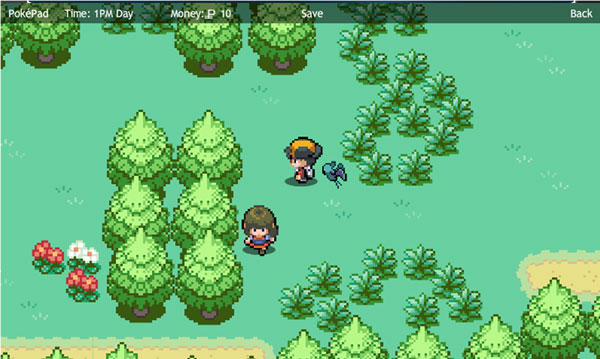
Pictured above is the Oran Berry Girl who can be found pacing furiously next to some trees of little relevance in the middle of Route 29; talking to her begins a battle which can yield some useful experience points for your Pokémon as well as the chance to catch a shadow Pidgey (day) or shadow sentret (night).
As the main character in the midst of a Pokémon-fuelled adventure that takes place within a tower defence game, you get the feeling that if something needs defending, it is probably you that is going to have to step up and be the defender. In this case, the defence takes the format of a multiple-enemy battle but with the enemies moving vertically from below towards the Oran Berries at the top; their aim is to sneak past you and the girl in order to deceitfully swipe the berries and exit by retracing their steps to the bottom of the screen.
The battle should be treated like any other wild battle, but depending on whether your aim is to capture the offending Pokémon or whether to simply defeat them all for the purpose of collecting the precious experience points as a reward, you should adjust your tactics accordingly. Capturing your Pokémon has been previously discussed along with the best methods of gaining experience points. The reason that the defending of the Oran Berries is so advantageous is because of the ability of the girl to heal your Pokémon, which has the effect of taking the fear of damage to your Pokémon out of the equation and letting you focus on attacking only.
You should place your weaker Pokémon that are in need of experience points at the bottom in so it becomes impossible for a Pokémon to pass without them squeezing out a few attacking moves in their direction. Stronger Pokémon can be placed above your weaker ones in order to finish the job; this battle formation facilitates the weakening and demise of the offending creatures, resulting in a nice portion of experience points for your weaker Pokémon. Should any of your creatures be a little hard-up in the health department at any point in the battle, simply place them in one of the three zones in front of the girl and she will somehow give your Pokémon a complimentary nursing back to full health so that they may fight without fear of fainting.

Arrangement of Pokémon in the 'Battle of the Oran Berries' where the weaker Pokémon are placed either side of the arena at the bottom and the stronger Pokémon situated above them (left). The healing powers of the helpful girl make this battle a useful tool for amassing experience points with minimal risk of your Pokémon fainting (right).
As with any of the advice in this guide, whether you decide to enter into this battle is entirely up to you. While the battle yields no physical reward such as Potions or Oran Berries (even though you just bravely defended a bunch of hers), it does serve as a useful tool that is available at your disposal in order to gain some valuable experience points for your weaker Pokémon, or even to help level up your stronger ones. Since you can repeatedly talk to the girl and keep entering the battles endlessly, the ‘Battle of the Oran Berries’ will always be there for you to use in order to gain more experience points than you would in normal encounter with wild Pokémon.
I’d love to, but she’s just not my type
Having covered various methods on how to go about gaining considerable amounts of experience points from wild battles, boss fights and trainer battles, it feels like it’s about time that I move on to the more technical side of things. Considering the complexities of the Pokémon universe in general, I’m surprised that I haven’t dipped my feet into these choppy waters of technical detail already, but I felt it necessary to first cover some general tactics, giving you the advantage of perfecting your fighting techniques and your Pokémon before troubling yourself with the actually types of Pokémon you are fighting with.
Now, I’m not referring to the kind of Pokémon, i.e its actual name (Bulbasoar, Blastoise, Wartortle etc.) but its specific species/type such as water, fire, leaf, poison and many, many more types that give such rich diversity to the complex paradise that is the Pokémon world. When it comes down to it, Pokémon of certain a certain species and type will have a tactical advantage over other certain types of Pokémon during battle. The most applicable of examples would be that Squirtle, a turtle/water Pokémon, has a distinct advantage if he is fighting Charmander, who is a flame Pokémon. Just as the trusty principles of physics will apply when water douses a flame in this non-fictional world, attacking a flame-species Pokémon with water-type moves will result in the moves being super-effective against your opponent. Conversely, if you are on the receiving end of a water-based move as a flame-species Pokémon, your day is about to take a turn for the absolute worst.
I won’t persist in the practise of continuing to force endless numbers of examples upon you; I simply want to stress that it is this exact principle of differing Pokémon types which applies directly to any battle you undertake in Story Mode. I do not claim to have in-depth knowledge of every available Pokémon within the game, or indeed the individual types of these available Pokémon; I simply wish to remind you of some of the types encountered so far and how this knowledge can help you during battle The idea of Pokémon type is something you can take into every single battle that you encounter, and it is an idea that can give you the advantage over your opponent, or indeed mean the difference between sweet, sweet victory and bitter, difficult-to-swallow defeat.
Your very first decision of which of the three starting Pokémon to choose at the game’s outset is a perfect embodiment of the importance of Pokémon type when battling in Pokémon Tower Defence 2. The choice is between a fire, a water and a plant Pokémon; different combinations of these are super effective against each of the others, and this is reflected in the first battle of the game (even though it turns out to be a dream, the Pokemon rules still apply).

The trademark of all Pokémon games to date involves the choosing of a starter Pokémon from three very different types; Plant, Fire or Water (left). The imaginary first battle of the game is reflective of the importance of Pokémon type, with the photo showing Flame-type Cyndaquil attacking the leafy Chikorita, with devastating results (right).
The Pokémon I chose was Cyndaquil, a fire Pokémon which happens to an excellent Pokémon of choice when battling against plant Pokémon, which are fairly commonplace in the wild. It is pretty difficult to wander through the ‘Route X’ areas in the game without running into either Caterpie, Metapod, Bellsprout or Weedle at some stage, and owning a fire-type Pokémon proves incredibly useful. Choosing Chikorita would have put me at a distinct disadvantage should I go up against any fire Pokémon, but on the other hand, facing Rock-type Pokémon would have been a breeze, and it just so happens that Geodudes are encountered in the Rock Cave and at the entrance area to Mountain Road. Flying Pokémon are extremely susceptible to attacks from electric Pokémon, though I haven’t yet managed to spot an electric-type Pokémon wandering around in the wild.
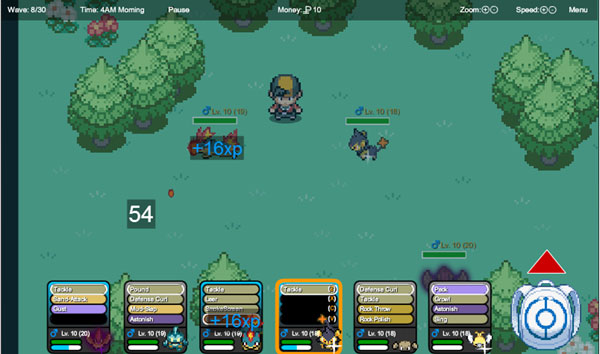
Fire-type moves prove to be extremely effective against plant-type Pokémon; needless to say, my Shiny Shinx and Shadow Pidgeotto didn't get to see much of the action in the wake of Quilava's Ember move.
I feel like I should point out that just because you may own a fire Pokémon for example, it doesn’t mean that it will instantly be super-effective against a leaf/plant-based opponent. In fact, it isn’t until your Pokémon actually learns a fire-type move that you will begin to reap the rewards of choosing your fire-based Pokémon. Cyndaquil, for example, begins with normal-type moves such as tackle and leer, and will not learn fire-type moves like Ember until you raise it to a certain level. This is usually true of most of the Pokémon encountered in Pokémon Tower Defence 2; you really have to put in the time to train your creatures so that they level up and learn more and more specialist moves that are characteristic of their particular Pokémon type.
It works slightly differently in terms of defence: if, to use another example, you own a Geodude (rock type) and you go up against a Pikachu (electric type), then you may not be super-effective against it, but defensively, you are laughing all the way to the metaphorical bank because electric-type attacks are extremely ineffective against rock Pokémon. Simply put, the type of your Pokémon can effectively be as much an advantage for your defensive capabilities as it can for your offensive game. It all comes down to a little experimentation; that and a great big chart that I have managed to locate on the miraculous web of world-wide proportions (the credit for which goes to Pokémon Database).
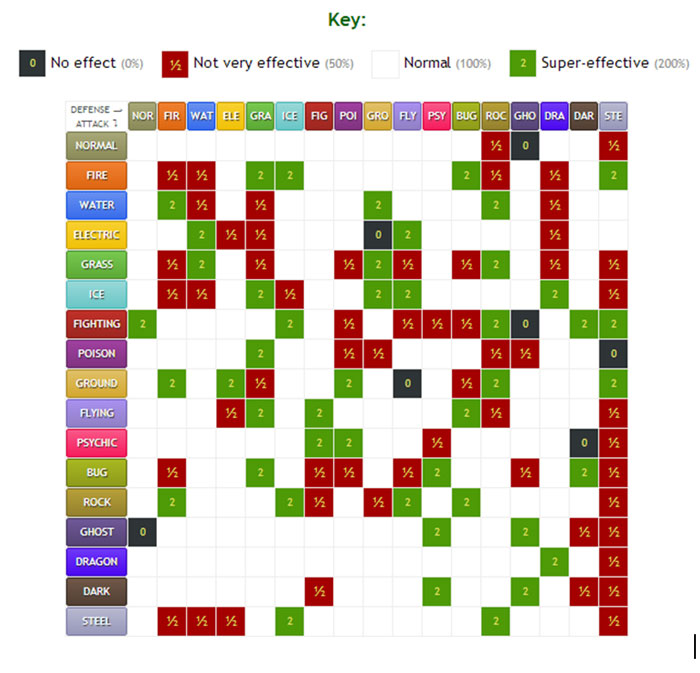
This chart is a handy device which readily displays the advantages/disadvantages that all the different types of Pokémon possess when facing each other.
Some of the more unusual types of Pokémon in the game also exhibit traits that are advantageous in nature. Apart from their fabulously sparkly appearance, the other property which ‘Shiny’ Pokémon possess is the ability to gain up to fifty percent more experience points than their counterparts of regular complexion. Sadly, the chances of catching a shiny Pokémon in the wild are slim to absolute zero; the only reliable way to go about securing yourself one of these kinds of Pokémon is to take advantage of the weekly mystery gift (discussed below).
Shadow Pokémon are also available for capture in the game. Their appearance is identical to that of regular Pokémon but they are shrouded in a purple hue that gives them an ominous appearance. As far as I can determine, these Pokémon do not exhibit any advantages over their regular, non shadow counterparts, but they are able to learn shadow-type moves. These Pokémon are not often found wandering in the wild but can be seen in some battles such as when you help Zai with her Oran Berry problem; shadow Pokémon do not appear every time but when they do, it is announced by the game so that you can be ready to wear down its health and capture it.
One Gift Please, but I can do without the mystery
As possibly one of the ultimate examples of the wonderful interactivity and constantly-evolving nature of Pokemon Tower Defence 2, the weekly ‘Mystery Gift’ is a useful tool that offers you the chance to receive a new Pokémon each week, and is quite frankly a novelty that never gets old. Located on the main menu and accessed exclusively from the ‘Play Tower Defence Games’ website, the Mystery Gift function requires that you enter a code that can only be obtained by solving a number of clues (related to tower defence games and/or Sam & Dan games) that are also located on the website mentioned in the previous sentence.

Enter the weekly Mystery Gift Code to receive Pokémon that are otherwise not readily obtainable within the confines of Story Mode.
Of course, what kind of guide would this be if it did not offer you an easier way around this task (which quite frankly sounds a little tiring for those who are not accustomed to putting in large amounts of effort into their flash game strategy). The code can be easily be obtained by either searching the internet, or you can also witness its unveiling on a weekly basis on thePokémon Tower Defence 2 Wiki. YouTube is also a good source of Pokémon Tower Defence 2 information in general, with Pokémon Tower Defence 2 fans across the world posting the mystery gift code on a weekly basis for all to use.
Sadly, each code expires when the next is made active, so you cannot use any of the previous codes once they have expired a week after their release. Do not fear; you can still obtain all future Mystery Gift Pokémon by simply obtaining the next code and entering it. The Pokémon that are given away as part of this novelty offering are often of the shiny variety and are therefore worth adding to your collection. Though they may begin at a feeble level one, their tendency to rake in relatively larger quantities of experience points from their participation in battle means that it won’t be long before your shiny Pokémon grows into a high-level creature that you can be proud of.
Let It Shine
A significant number of the strongest Pokémon in my team are shiny ones which I managed to obtain as part of the weekly Mystery Gift. Shiny Pokémon are well worth some serious consideration as future members of your posse of Pokémon; they level up at a significantly faster rate than regular Pokémon, the moves they tend to learn can often be pretty powerful, and finally, they’re more sparkly than Christmas, and twice as heavy on the giving. It’s like having a delicate-looking decorative Pokémon that packs significantly more punch than its appearance would lead you to believe. In fact, such is the extent of the effectiveness of the shiny Pokémon, I managed to train up my recently-acquired and satisfyingly sparkly Jirachi from level 1 to level 18 in a period of time that spanned no more than twenty minutes. I felt pretty smug about the whole thing until I rememberd that flash-game success does not equate to real-life achievement. Still, my level 18 Jirachi brought a quantity of happiness to my silly face that perhaps a flash-game shouldn’t be able to provide.
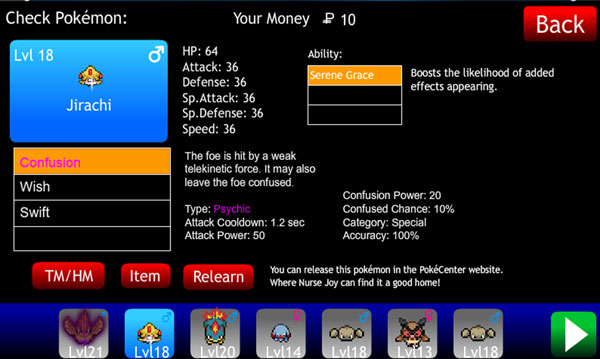
Due to Jirachi's ability to rapidly acquire experience points, as well as his devastating 'Confusion' manoeuvre and his delightfully merry shine, he stands at level 18 a mere twenty minutes after joining my collection.
I will concede that it is a little irritating that your mystery-gift Pokémon arrive with their standard factory settings. In fact, when you collect your shiny Pokémon, they arrive in your collection at a measly level 1 as standard but it is most definitely worth the effort to train them up to a higher level, if only for the fact that they grow up at an impressive speed that will leave your other Pokémon with a bad case of level envy.
Burn the candle at both ends
One of the distinguishing features of Pokémon Tower Defence 2 is the inclusion of a day/night cycle. As you are travelling through the ‘Route’ areas in the game, time ticks away and is indicated at the top of the screen. The transition from light to dark isn’t simply superficial in nature, however; the availability of some wild Pokémon is actually determined by the time of day in which you hunt for them.
While a majority of the Pokémon within the game can indeed be found wandering around during the day, some are found exclusively under the cover of dusk and darkness. These dark-loving Pokémon include Hoothoot, Shadow Hoppip, Spinarak and Gastly, with more Pokémon certain to be included in future updates from Sam of the Sam and Dan duo. Phanphy is a Pokémon which can only be obtained in the morning from Route 46 (north of Route 29), while Jigglypuff can only be found in this area during the day.
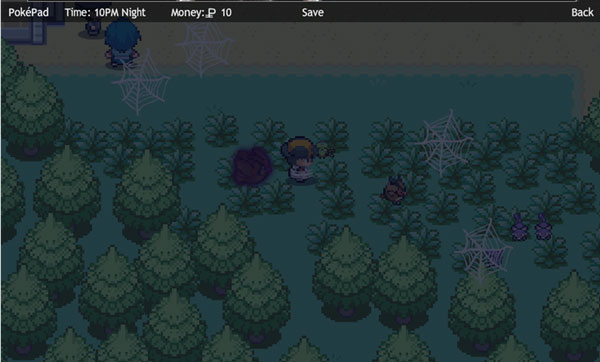
The availability of some Pokémon is dependent on the time of day; Spinarak and Hoothoot are prime examples of these, and keep your eyes peeled for the elusive Gastly in Route 31.
I like the Way You Move
When training and battling your Pokémon for the purpose of gaining experience points, there are most definitely some Pokémon that have a distinct advantage over others due to the powerful moves which they go on to learn should you persevere with their training. It pays to know that due to the devastating power of these moves, you will be able to enter into wild battles with the knowledge that your Pokémon will be able defeat your opponents with these moves with a relatively small number of hits. Because you will be unlikely to require the assistance your other Pokémon to defeat the transient creatures, this advantage results in the ability to acquire a large number of experience points from wild battles and therefore an accelerated levelling-up process.
By including this section in the guide, I am by no means suggesting that owning these Pokémon with excessively powerful moves is essential to your progress in the game; I am also not making the assertion that I am in possession of some kind of closely-guarded secret or specialist knowledge about the game. After all, training up powerful Pokémon and selecting a team that possesses an advantage over your opponents is an entirely logical tactic, and is quite frankly the whole point of Pokémon in general. I have included this section in the guide for the purpose of informing anyone who may not be aware of the information included within it; by using the following Pokémon, I have managed to increase their levels relatively quickly by concentrating on using their most powerful move during battles.
Geodude
The first of the Pokémon within the game that will provide you with a distinct advantage over others because of the moves they posses (or will eventually learn) is Geodude. Aside from his incredibly inflated defensive capability which comes as standard, he also has the ability to use Defence Curl in order to increase his resistance to damage from other Pokémon. The main reason I have singled Geodude out in this rundown of Pokémon of considerable power is that training Geodude up to level 11 will allow him to learn the ‘Rock Throw’ move. This rock-type move is noticeably more powerful than using Tackle and is the move that made defeating Falker (the first gym leader) possible. Because of this move, you can enter Geodude into battles with wild Pokémon and simply sit back and watch the experience points roll in. The best news is that the type of Pokémon you face rarely matters; Rock Throw is so powerful that it can be used against most Pokémon types and the results will still be overwhelming across the board.
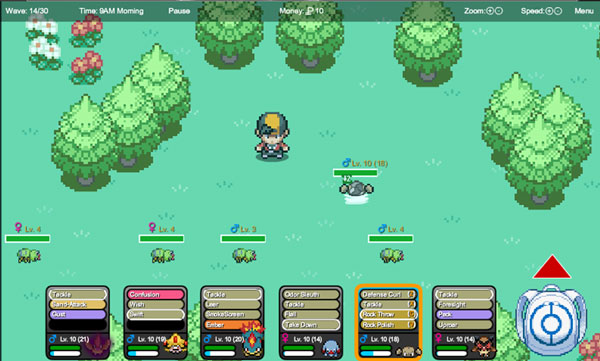
Geodude's Rock Throw move makes quite the stir during wild battles, enabling you to defeat Pokémon with only a few uses of the move and allowing him to mop up experience points by the barrel.
Shiny Jirachi
Available for a limited time only, Shiny Jirachi is one of the Pokémon obtainable only by redeeming him from the Mystery Gift section of the game. After a lot of searching and riddle-solving that is a requirement of the Mystery Gift giveaway (also known as ‘Googling the answer’), I picked up Shiny Jirachi at level 1 (as with all Mystery Gift Pokémon) and was very close to being blown away by the speed at which he gained experience points and levelled up. When I finally managed to draw my attention away from the gleaming shine that defines his appearance, I began to realise that using his Confusion move became an increasingly effective technique for defeating wild Pokémon with only one or two hits. This cycle of increased power due to levelling up, and accelerated pace of levelling up due to his increased power makes Shiny Jirachi a formidable Pokémon to have on your team; just use his Confusion move and you will not be disappointed by the results.
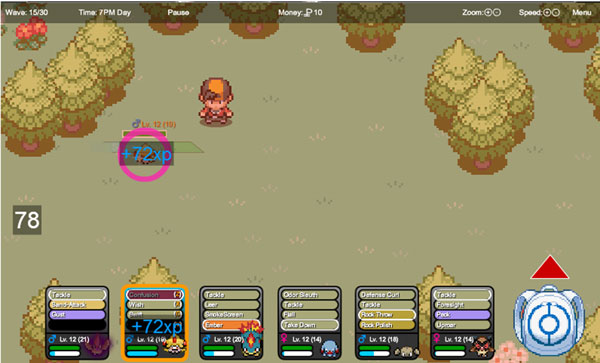
Use of Confusion by Jirachi almost seems like an unfair advantage during wild battles; the extent of his effectiveness means that using other Pokémon to mop up the survivors becomes almost unnecessary as a primary tactic.
It’s Super-Effective!
The above two Pokémon aren’t the only ones which can deal out a world of pain with a single move; there are plenty of Pokemon that can be captured in the game which, when trained up to a level that is sufficient to learn their specialist moves that are of the same type as the Pokémon, can take down opponents with only a few attacks. Taking advantage of your Pokémon’s type in a battle is essential, and can mean the difference between flying the flag of victory and eating the dirt of defeat. Using a Pokémon whose moves are super-effective against that of your opponent means a hasty victory and therefore more experience points for your attacking Pokémon. The following is a list of just a few Pokémon and the opponents against which they are likely to be victorious, seeing you through to almost certain victory in most of your battles.
Starting Pokémon
Regardless of whether you chose Chikorita, Cyndoquil or Totodile as your starting Pokémon, you will eventually have an advantage over some of your opponents due to their specific type. Cyndoquil’s Ember manoeuvre will make short work of Plant Pokémon such as Bellsprout and Bug Pokémon such as Caterpie. Chikorita’s grass-type nature means it will learn Razor Leaf at level 6 which will make short work of rock-types like Geodude (it is also effective against water Pokémon, though there are no opportunities to encounter these in the wild as of yet). Totodile will put to waste any Pokémon that are unlucky enough to hail from a ground, fire or rock-type background. In all, I have found Cyndoquil to be the most useful of all the starting Pokémon; Ember seems to prevail during many wild battles, and is moderately effective against most Pokémon, regardless of type. With Pokémon being such a diverse game, however, there are many other Pokémon available to you that can take advantage of these type-advantages.
Bellsprout
Whether you fancy capturing a few Geodudes or simply ruining the days of rock, ground or water Pokémon, Bellsprout is an essential weapon in your Pokémon arsenal. Its Vine Whip is one of the few moves that are super effective against rock Pokémon, particularly if you have chosen Cyndoquil as your starting Pokémon, who is quite the useless appendage when battling against rock types. Additionally, with its ability to learn Sleep Powder at level thirteen, Bellsprout can provide a tactical advantage if it is included in your team; using Bellsprout to inflict status afflictions on passing Pokémon in order to halt their movement during a battle is a clever way to tip the odds in your favour.
Gastly
While this ghost-type Pokémon won’t be winning any awards for its shattering attacking moves, it certainly knows how to hold its own in terms of defence. With its special ability known as ‘Levitate’, it is resistant to all ground-type moves and takes minimal damage from other types, if any whatsoever. Its imperviousness to attacks from all but Ghost, Poison and Bug Pokémon makes it a sensible choice to have in your collection to be called upon should the situation arise.
Such formidable defensive ability is certain to make up for its lack of sufficiently powerful attacking moves; these are sure to be added when the ‘soft cap’ in the game is lifted (the ‘soft cap’ is explained in the blog as being the level at which Pokémon cease to learn moves by levelling up). Though the soft cap is currently set to level 12, it is due to be raised to 14 in the near future; when the wondrous day arrives that the level cap is raised to 20, Gastly will be able to learn ‘Psychic’, at which point opposing Pokémon truly would have something to fear.
Shiny Shinx
Once upon a time I entered the weekly Mystery Gift code and made my way to the online Pokécenter in order to receive the spoils of my efforts (which involved googling the code and clicking on the relevant results; it was a busy day for me); I was greeted with none other than a Shiny Shinx, which I then collected, sent to my profile and in my naive foolishness, left to gather dust in the Pokéstorage section of my game profile.
It wasn’t until today that I realised what a catastrophic error in judgement I had made; after dusting him off and entering him into my collection at an infantile level 1, he now stands at level 20 (after quashing his multiple attempts to evolve) and at the head of my Pokémon team. I am not issuing these complimentary words merely because he is shiny; I enjoy a shiny object as much as the next man lacking in an attention span, but these words of flattery are not intended purely to make Shinx blush. I feel that I should offer these words in order to prevent anyone reading this from making the same mistake as I did. In contrast to being sniffed at and discarded, Shinx should be a Pokémon that is treasured, admired and dare I say it, worshipped. Perhaps that latter display of appreciation is a little too extreme (I am treading through dangerous territory by suggesting that fictional creatures should be worshipped as if it were a deity or supreme being), but it is only because of Shinx’s extremely useful properties and fearsome battling attributes that I am being so extravagant with my use of excessively superlative imagery in the first place.
An electric type Pokémon that looks as cute as the fluffiest of buttons, Shinx (who is only comes in Shiny form in Pokémon Tower Defence 2) is a Pokémon that –aside from its ability to level up at an accelerated pace - initially doesn’t stand out from the crowd. Before level 13, it only possesses normal-type moves such as Tackle and Leer, as well as learning ‘Charge’ at level 9, which is a electrical move that at this early stage simply charges Shinx up for an electrical attacking manoeuvre that it doesn’t yet possess. At level 13, however, Shinx learns ‘Spark’: this milestone is where my opinion of the little fellow changed dramatically.
The abundance of Pidgeys in Route 29 and Route 30 allows you to use Shinx’s super-effectiveness against flying Pokémon in wild battles: you will be surprised at how quickly he will gain experience points by being deployed as the sole Pokémon in these battles. Using ‘Charge’ to increase the power of his ‘Spark’ move allows you to take down flying Pokémon in one hit, occasionally requiring two just to be sure.
Perhaps the most gleaming testament to Shinx’s effectiveness is his ability to single-handedly defeat Falkner without the help of another Pokémon, and all this achieved in less time than it took two Geodudes to take him down by attacking him simultaneously. By using his Charge move before using any attacking manoeuvres, the effectiveness of his Spark move is increased substantially, thereby becoming more devastating to his opponents; so much so that he can take on a level 25 Pidgeotto and a Level 30 Pidgeot single-handedly. The likelihood of electrically-induced paralysis in his victims also reduces the frequency at which his opponents are able to perform any moves (this phenomenon is most obvious observed when battling against Falkner), which effectively blunts the attacking power of both his Pidgeotto and Pidgeot to such an extent that the battle becomes easy to the point of ridiculousness.

Shinx makes light work of Pidgeotto with a combination of the Leer, Charge and Spark moves; the same techniques are applied to Pidgeot whose frequent paralysis as a result of the electrical attacks cause Falkner to watch in nothing less than horror as his swathes of Pokémon are taken apart by a single, sparkly foe. So much for his pre-battle smack talk.
Shinx’s passive abilities also add to his overwhelming effectiveness in battles against flying Pokémon, as well as his considerable capabilities in handling pretty much all wild Pokémon battles you are likely to come across (with the exception of battles against ground-type Pokémon). Using his ‘Intimidate’ ability will reduce the opponent’s attacking stats by one, effectively making impotent their attacking power against you, whereas ‘Rivalry’ will deal more damage to an opponent of the same gender. Using these abilities (‘Intimidate’ in particular is an effective one) will see that a majority of your opponents simply won’t stand a chance against you.
Tiny Tip
Use Shinx as a secondary soldier in your efforts to level up a weaker/more vulnerable Pokémon: Wild battles against the plentiful Pidgeys in Routes 29 and 30 can become a nutritious (even delicious) source of experience points for your lower-level Pokémon. Simply deploy your weaker Pokémon to the far left and Shinx to the right of this one; this way, your weaker Pokémon can squeeze off a few moves while Shinx finishes them off as they pass, creating an unstoppable duo of devastation with a knack for levelling up.

Shinx has been instrumental in the speedy levelling up of my Pokémon team: Spearow gets first dibs on the passing victims while the shiny, high-voltage feline mops up the survivors. The 'A' Team have nothing on this duo.
If I had my way, I would continue this already-lengthy soliloquy regarding my thoughts and feelings about Shinx as a Pokémon and indeed as a distracting, shiny object that catches your eye like the reflection from a raindrop atop an increasingly auburn leaf in the autumn. Sadly, I shall end my praises here, but leave you with one last reminder that with Shinx in your possession, you have the potential to create an almost unbeatable Pokémon team.
Spearow
Now, before you become agitated and raise your imaginary hand to grab my attention and point out to me that Spearow isn’t by any means a fearsome, difficult-to-defeat and all-powerful Pokémon that belongs in any lists of the ‘Top X Pokémon’ kind, I would like to say that this is not the inference that I am making by including him in this list. His presence here is simply because of the delightful assortment of moves he goes on to learn as he grows, the different type of the moves that he acquires and more importantly the effectiveness of having a varied set of attacks that hail from different typesets. Starting with a modest collection of moves consisting of ‘Peck’ and ‘Growl’, Spearow will go on to learn Leer (level 5), Fury Attack (level 9) and the dark-type move ‘Pursuit’ at level 13. This set of move proves to be an extremely useful combination to wear down Pokémon of various types. I made sure to replace ‘Growl’ with ‘Leer’ when he came to learn it because it is an altogether more useful move.
Being of the flying-persuasion, Spearow is extremely effective against Grass, Fighting and Bug-type Pokemon; this can be witnessed when using ‘Peck’ and simply watching the Caterpies and Bellsprouts reel accordingly. Fury attack is a normal-type move but deals out a fair bit of damage as well; ‘Pursuit’ is a dark-type move, is super-effective against Psychic and Ghost Pokémon (bad news for Gastly) and serves to inflict double damage on Pokémon of any kind as long as their speed stats are inferior to yours. Add ‘Leer’ into the mix as a way of lowering your opponent’s defences, and I hope you can see why Spearow’s presence in this list is perfectly justified.
Rattata
Now I know for a fact that there will be opinions that fall on directly the opposite side of the ‘Pro-Rattata’ fence, and this is understandable. After all, there isn’t all that much that is special about Rattata, and his moves are rarely super-effective against most of the Pokémon that can be found thus far in the game. It can’t hurt to have a Rattata at your disposal, however, since he is another Pokémon that is similar to Spearow in this respect in that he possesses largely normal-type moves but goes on to learn ‘Bite’ which is another attack of the dark variety. Occasionally opponents will flinch at this attack and as a result will neglect to take their turn in attacking you. His combination of Quick Attack, Bite, and tackle make for an effective combination of moves against most types of foe, while ‘Focus Energy’ (learnt at level 7) increases the likelihood of a critical hit.
This combination of moves makes Rattata a solid, all-round Pokémon to have in your collection. Now we just play the waiting game for the ‘soft cap’ in the game to be raised to level 16 and he will be able to learn Hyper Fang; Pokémon will soon cower in the face of this tiny rodent as a result and it will be well worth the wait.
Dark Pidgey/Pidgeotto
Obtained during the daytime from the ‘Battle of the Oran Berries’ with Zai (the Dark Pidgey will appear a small percentage of the time at the end of the battle when all the other Pokémon have been defeated), this Pokémon doesn’t really have any overwhelming advantage over many of the foes that have been encountered thus far during Pokémon Tower Defence 2. In light of this, you may question why I have singled this Pokémon out from the crowd with no less than multiple-space separation from the main body of text and bold typeface. I had no hesitation including Dark Pidgey because he has formed a significant part of my attacking team and has continued to remain there, standing shoulder to shoulder with my Shiny Shinx and Jirachi in its attacking capability.
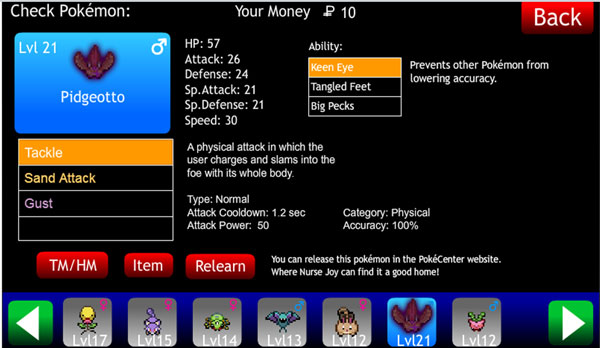
While its collection of move may not fill you with overwhelming battle-confidence, Dark Pidgeotto is as formidable an opponent as you will come across (at least in Pokémon Tower Defence 2, anyhow), and its choice of three abilities will give you extra advantages along the way.
Pidgey does not offer the fantastically damaging attacking power of Shiny Shinx or Shiny Jirachi, however. In fact, its moves are fairly unremarkable, starting with Tackle, learning sand attack at level 5, Gust at level 9 and Quick Attack at level 13; it is simply a case of training him up through the levels and watching his power grow. I allowed him to evolve into Pidgeotto and he is currently at level 21 (though bear in mind the area-dependant level caps within the game) In most wild battles, he can act as the Pokémon who mops up the survivors on the extreme right of the screen, or he can take on most Pokémon alone with the combination of Quick Attack, Gust and Tackle; just pop him into the battle and watch the opponent’s health deflate like a poor-quality balloon at the birthday party of a disappointed child.
Cyndaquil/Quileva
Though I have already craftily included a section that covers the starting Pokémon, I feel that Cyndaquil and his evolved form of Quileva deserve singling out because of the effectiveness of fire Pokémon against Bug and Plant-types. This reasoning may seem like a ‘Duh, Obviously!’ statement of the blindingly apparent to most Pokémon fans, but this does not detract from the fact that quite a few wild Pokémon you face in the wild (the defeat of which will gain you experience points in order to level up your precious little creatures) will be of the Bug/Plant/Grass type such as Caterpie/Weedle (depending on whether you are playing Gold or Silver version), Metapod/Kakuna (again, version- dependent) and Bellsprout.
You will find that your battles against these Bug, Grass and Plant types will run much more smoothly with Cyndaquil/Quileva using his Ember attack, which is super effective against these types and may also lead to your opponents suffering from a repeatedly-damaging ‘burn’, a status ailment that repeatedly inflicts damage for as long as the suffering Pokémon continues to be burned.
Caterpie
Ok, so Caterpie doesn’t exactly look like a fearsome Pokémon, and in all fairness, his moves are also lacking the qualities of an effective attacking Pokémon as well. I’m talking qualities such as power, speed, and generally the ability to be able to have any kind of lasting impact on a battle whatsoever. Train Caterpie up a few levels, however, and you will begin to see his potential: after evolving into his transitional and infinitely-useless Metapod stage at level 7, you will learn Harden (this is a defence-strengthening move that you should definitely hold on to) and perhaps think nothing more of him. Further pursuit of his training up to level 10 will yield favourable results that make your investment of time and effort into Caterpie a worthwhile endeavour.
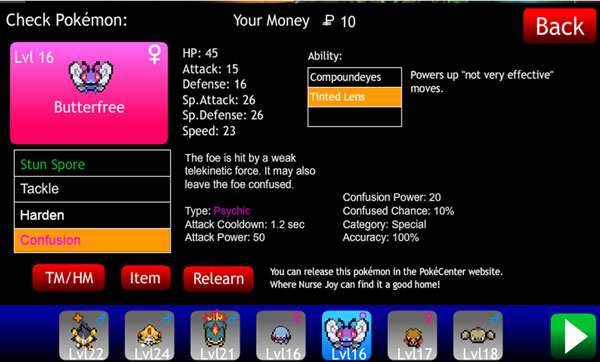
Your choice of moves may vary but Butterfree has the potential to be the possessor of moves of the Psychic, Normal and Grass type-set; it's a long way from the poor excuse for a Pokémon that is Caterpie.
At level 10 you will learn Confusion (the move which makes Butterfree such an effective Pokémon to possess), and through levels 12, 13 and 14 you will have the opportunity to learn Poison Powder, Stun Spore and Sleep Power; the choice is up to you, but regardless of your selection, Butterfree is now a Pokémon that can pretty much devastate all who should fall into his attack range.
With his combination of Harden (to be used for defensive purposes) and Confusion (a powerful attack which can deal considerable damage to Pokémon of most types), Butterfree can be used in all battles to inflict damage, give backup to your weaker Pokémon or simply deployed and set to ‘Confusion’ in order to collect large numbers of experience points. My personal favourite attacking formation is the combination of Butterfree and Jirachi; with both Pokémon set to attack with Confusion, the Pokémon caught in their wake begin to regret waking up that morning since for them, it was definitely on the wrong side of the Pokéball.

Wild Pokémon just don't stand a chance against the potent combination of Butterfree and Shiny Jirachi; doubling up with 'Confusion' may seem excessive, but it makes for a speedy system of training and a whole lot of success in your battling enterprise.
Trading places
If the tough life of a Pokemon trainer doesn’t appeal to you, then you always have the option of getting involved with a little bit of insider trading. Now, I am not referring to the act of trading stocks and bonds facilitated by the possession of privileged information, since this would make absolutely no sense in the context of Pokémon; I am in fact referring to the practice of entering your Pokémon into the trading section of the Pokécenter in order to swap said Pokémon for one that another player is equally as willing to relinquish, should one of yours catch his or her eye that is. The system also works in the opposite direction whereby you can facilitate a trade if you see a Pokémon out there that you simply must have in your collection.
There are several advantages to finagling yourself a cheeky trade here and there: the first is that you can set the parameters of the search for your trade by selecting which Pokémon you desire along with a range of filters such as its gender and type. Far from the tedious process of wandering about in the wild and catching a weak version of the Pokémon you desire, trading is a relatively simple affair if you happen to own a Pokémon that someone else desires; you simply enter your trade request in the Pokécenter trading section and wait for a response. You can also obtain a code upon making one of your Pokémon available for a trade; this allows you to direct your trade to a particular person, or indeed makes it possible to post onto the boards of your favourite Pokémon forum. As you can see, your options are very much open.
Should your trade be met with a positive response from a willing swapping enthusiast then proceedings can do what they do best and proceed; your Pokémon will be dropped off into your profile for you to collect. You can also browse the pages online and initiate a possible trade by clicking the ‘request trade’ link.
As well as being much more convenient than wandering around looking for Pokémon to catch in the wild, the trading system gives you the opportunity to trade for a Pokémon of a relatively high level, cutting out the long and often arduous process of repeatedly entering into an exhaustive number of wild battles in an attempt to acquire enough experience points to grow your Pokémon into an acceptably buff fighting machine. Why not cut out the middle man and swap an unwanted Pokémon for one that is already a veteran of PokéCombat? This option is sure to attract a number of players who wish to expand their Pokémon collection without spending countless hours wandering the routes of the game in search of wild battles.
Trading is also gives you a chance to acquire Pokémon that are otherwise unobtainable to you. A prime example of this is the Pokémon that are given away on a weekly basis as part of the ‘Mystery Gift’ section of the game. There are few things more frustrating to a fan of Pokémon Tower Defence 2 than to realise that they are just one day late in the hunt for the most recent shiny Pokémon to become available. Due to the transient nature of the availability of these gift Pokémon coupled with the desirable nature of those that form part of the weekly giveaway, the trading function can be a saving grace for anyone who may have been a little slow on the uptake when keeping up to date with the world’s best (and only) Pokémon tower defence game sequel.
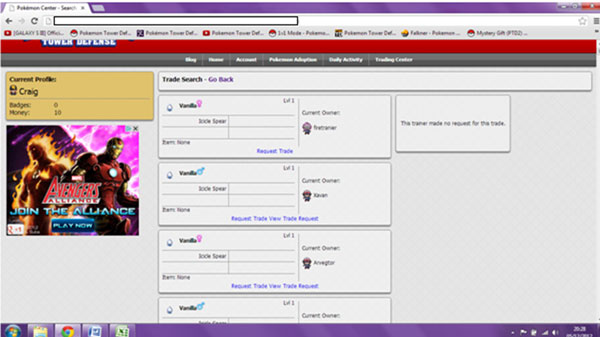
Missed your week-long window for the previous Mystery Gift Pokémon? Wipe the tears from your face and for heaven' sake stop crying since you can still obtain Pokémon whose gift codes are long expired; simply enter into the practice of trading your Pokémon to ensure that your Pokémon collection isn't suffering from a lack of variety or missing last week's shiny giveaway!
Rolling in it? Then buy fictional success, with actual money!
If the already-rich selection of Pokémon available to you in the Gold and Silver versions of Pokémon Tower Defence 2 still doesn’t satisfy your need for flash-based pocket monsters, or perhaps your craving for rare and shiny Pokémon exceeds the level that the weekly mystery gift is able to satiate then you always have the option of engaging in a spot of Pokémon adoption. That isn’t to say that there are hundreds of hungry, neglected or endangered Pokémon out there in the flash-based world that are looking forlornly into the camera being voiced over by a serious-sounding narrator and all with a backing of heart-wrenching music. The concept is much simpler than this; simply navigate to the Pokécentre and direct yourself to the adoption centre.
It’s a Status Issue
The time-consuming endeavour of earning experience points for your weaker Pokémon can be helped along with the strategic use of moves which inflict Status Ailments on your enemies. While these (usually) non-damaging moves alone do not inflict actual damage and therefore do not yield experience points if used as the sole method of attack, they can be incredibly useful in the manipulation of the speed of the passing enemies to your advantage. Moves such as Stun Spore, and Jigglypuff’s Sing hinder the progress of the passing foes and result in your other Pokémon being able to take advantage of the increased amount of time it takes for your enemy to pass; more attacks can be dealt to the hampered passers-by in the same amount of time, thus increasing the advantage that you Pokémon have over the enemy. This is just one example of how moves which effect the status of your enemy can be used to give you the advantage in a battle.
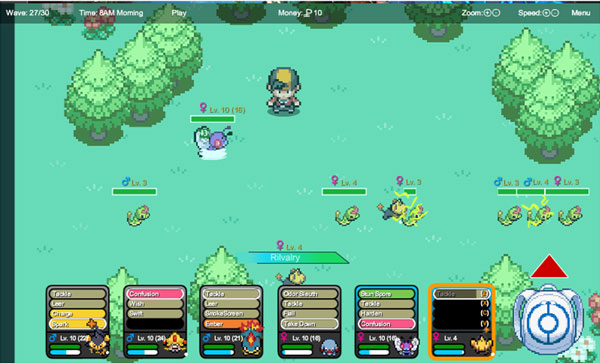
Using moves which inflict status ailments on opposing Pokémon has the effect of slowing the passing Pokémon, or stopping them altogether (in the case of Jigglypuff's Sing manoeuvre); these damaged specimens are thusly opened up to a whole world of pain as you use this opportunity to fire off more moves in their direction.
Hard Targeting
Making full use of the battling functions that are available to you in Pokemon Tower Defence 2 is what being a strategist is all about. One of the features of the game that is often overlooked and most definitely underused (at least by me, anyhow) is the handy ‘Targeting Options’ tab. Accessed by double-clicking any one of your active Pokémon’s move-list cards at the bottom of the screen during a battle, the ‘Targeting Options’ function allows you to effectively prioritise your attacks on passing Pokémon according to the various criteria that is available to you. You can choose to set your individual Pokémon ‘towers’ to target fast and slow-moving Pokémon, those with the least or most health, Pokémon against which your moves will be super-effective, even targeting only those whose health bar is on red. This function can be used to your advantage in battle, depending on your mixture of Pokémon and your intentions when battling.
They can be used for various other purposes, not least in conjunction with your status ailment attacks; setting your more powerful/higher level Pokémon to pick off the fastest-moving targets as your weaker Pokémon is set to catch the ones which are paralysed/slow-moving allows your selective targeting of your enemies instead of letting them slip by. Targeting your enemies in this way allows for more efficient collection of experience points, and is simply a good habit to get into which can be used in more difficult battles where even your stronger Pokémon may struggle to prosper.
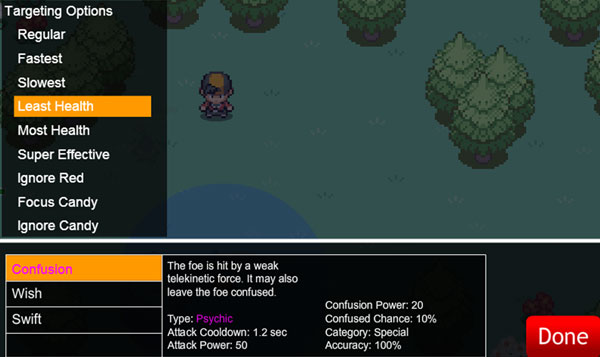
Making use of the 'targeting options' facility in the game is a way to direct your attacks to the opposing Pokémon that you feel are most relevant. The variety of options gives you the opportunity to maximise the potential of your active team.
This Concludes Our Broadcast Day
Since I have imparted pretty much all the knowledge I have accumulated so far that I have gained from playing Pokémon Tower Defence 2 at great length and at the expense of much of my time, this guide concludes here. Be sure to continue returning to Pokemontowerdefense.net for all your Pokémon Tower Defense needs and look out for updates and other guides for the games.
If there are any issues or strategies I have not covered in this guide that you would like help with or any questions you have, why not post a comment below and I will endeavour to answer them .
Guide by Craig Sherratt

